THE HUMAN FACTOR SERIES
Research to solve the political, cultural, economic dimensions of global issues
Malick Ghachem on how history can help us solve today's issues
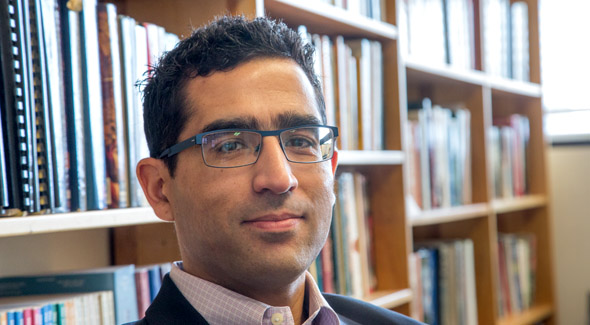
"One of the principal ways historians contribute to problem-solving work at MIT and elsewhere is by helping to identify what the real problem is in the first place. When we understand and articulate the roots and sources of a problem, we have a much better chance of actually solving it."
— Malick Ghachem, Professor of History
Malick Ghachem is an attorney and an MIT professor of history who explores questions of slavery and abolition, criminal law, and constitutional history. He is the author of The Old Regime and the Haitian Revolution (Cambridge University Press, 2012), a history of the law of slavery in Saint-Domingue (Haiti) between 1685 and 1804. He teaches courses on the Age of Revolution, Slavery and Abolition, American criminal justice, and other topics. MIT SHASS Communications asked him to share his thoughts on how history can help people craft more effective public policies for today's world.
___________
Q: Your new research focuses on economic globalization and political protest in Haiti, a country with a complex social, political, and economic history. What lessons can we learn from Haiti's history that can inform more effective public policies?
A: I think the most important lesson for public policy may be that we cannot ignore the distant past — and in the case of Haiti, by "distant past" I mean only so far back as the eighteenth century. (With apologies to colleagues who study the yet more distant centuries of ancient and medieval history!) Public policy has a short-term memory, however, and this is especially true of economic policy, which tends to look back only so far as the early twentieth-century to understand, for example, how a financial crisis comes about and what it entails.
Haiti showcases the decisive present-day impact and legacies of a history that goes back more than three hundred years, to the rise of the slave plantation system. My current work tells the story of a planter rebellion in the 1720s against the French Indies Company, an event that ended the era of slave trading monopolies in Saint-Domingue (as Haiti was known under French rule) and left large-scale sugar planters in effective control of the colony.
Some of the key political and social cleavages that have characterized Haitian life ever since date back to this period. A history of Haiti that begins with the revolutionary years leading up to Haitian independence in 1804, or any period thereafter, will necessarily lack a handle on just how deeply rooted are Haiti’s current circumstances.
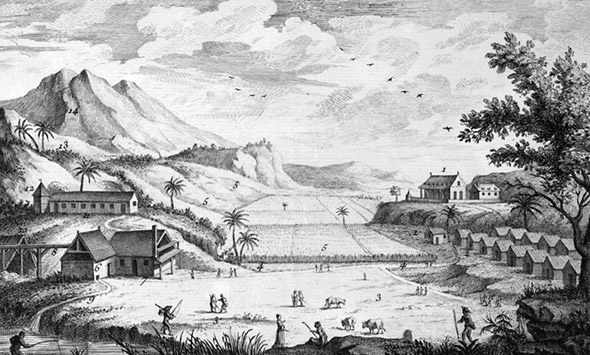
View of a Sugar Plantation, French West Indies, 1762; Denis Diderot, Encyclopédie, ou, Dictionnaire Raisonné des Sciences, des Arts et des Metiers
"A history of Haiti that begins with the revolutionary years leading up to Haitian independence in 1804, or any period thereafter, will necessarily lack a handle on just how deeply rooted are Haiti’s current circumstances."
— Malick Ghachem, Professor of History
We can see this on any number of levels. Colonial history continues to hamper prospects for broad-based education in Haiti, as my colleague Michel DeGraff’s work on the linguistic politics of French vs. Haitian Kreyòl powerfully demonstrates. The environment is another example. Part of the resistance to accepting the reality of climate change (whether in Haiti or elsewhere) is a reluctance to acknowledge that history in this deep sense matters. Yet it is clear that deforestation in Haiti begins no later than the seventeenth century, when French settlers began using trees for purposes of lumber and fuel. By the time of Haiti’s independence, the lack of forest cover had already left many parts of the country vulnerable to flooding.
That historical perspective, in turn, suggests one of the difficulties that besets even the most well-intentioned relief work in Haiti today. Such work tends to focus on repairing the immediate damage caused by the latest “natural” catastrophe, whether an earthquake, a hurricane-induced flood, or an outbreak of contagious disease. These tragedies rightly call upon the generous aid of first-responders, but after the sense of emergency passes, the eyes of the world often turn elsewhere.
An understanding of how these tragedies draw on the full weight of Haitian history encourages and even demands a longer-term commitment to the problems at hand. And it suggests that effective responses to what seem like essentially medical, environmental, or legal problems must cut across conventional categories of policy analysis and understandings of responsibility. Take the case of United Nations liability for the cholera outbreak in Haiti after the 2010 earthquake.
The natural impulse of human rights lawyers in that context was to file suit against the U.N., which then spent several years digging in its heels and denying its role in the outbreak. But the U.N.’s position in Haiti is a legacy of the much deeper impact that individual nations/states — most notably, France and the United States — have had on Haitian affairs over the course of three centuries. Framing responsibility in narrowly legal or chronological terms runs head-on into this reality and limits rather than expands our sense of the potential remedies.
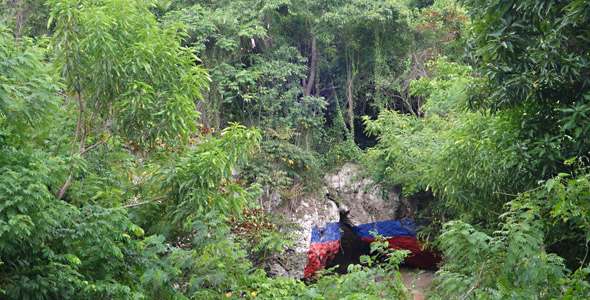
A rocky opening in the hills near Bois Caïman once used as an escape route by members of the Maroon community, now a Haitian national monument. Photograph © Malick Ghachem, 2016
"An understanding of how recent tragedies in Haiti draw on the full weight of Haitian history encourages and even demands a longer-term commitment to the problems at hand. And it suggests that effective responses to what seem like essentially medical, environmental, or legal problems must cut across conventional categories of policy analysis and understandings of responsibility."
Also see: Malick Ghachem on how Haiti helps us think differently about history.
Q: What connections do you see between economic conditions (including globalization and monetary policy) and the ability of a people or a culture to make innovations in science, technology, and public policy?
A: Waking up hungry each morning does not leave one with great deal of energy for scientific (or any other kind of) work during the day. The resources that make possible scientific and technological innovation are the same ones that sustain the relatively high standard of daily living many of us enjoy in the United States.
Haiti’s economy has long existed in a state of colonial dependency upon one or another foreign power; today it is the United States. The country’s economy is also beset by many woes, among them an ongoing currency crisis that makes the Haitian gourde an increasingly ineffective form of money. This fact places a premium on access to U.S. dollars, which elites and companies enjoy at the expense of workers paid in the local currency.
This is a crisis of sovereignty that takes the form of a monetary crisis.The earliest such currency crisis dates back (again) to the 1720s, and it’s one dimension of my current research. One of the two key triggers of the revolt against the Indies Company was a suspicion that the Company intended to eliminate the use of local Spanish silver coins, on which most colonists depended for their livelihood. The lack of a reliable and stable currency remained a problem throughout the colonial period and continues to severely constrict the economic horizons of many Haitians today.
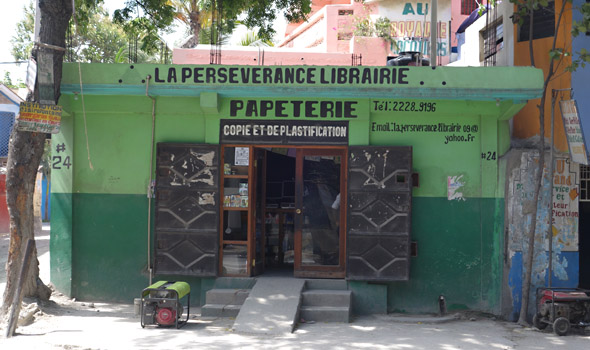
La Perseverance Librairie, in the Cul-de-Sac area near Port-au-Prince. Photo © Malick W. Ghachem, 2016
"It’s important to do the unglamorous, nitty-gritty, heavily historical work of understanding the local and the particular. A sustained patience for understanding the local in historical contexts is itself a tool of public policy — a way of seeing and talking about the world, and (if wielded correctly) an instrument of power and justice."
Q: As MIT President Reif has said, solving the great challenges of our time will require multidisciplinary problem-solving — bringing together expertise and ideas from the sciences, technology, the social sciences, arts, and humanities. Can you share why you believe it is critical for any effort to address the well-being of human populations, and the planet itself, to incorporate tools and perspectives from the field of history? Also, what challenges do you see to multi-disciplinary collaborations — and how can we overcome them?
A: President Reif’s observation is correct and important. We also need to appreciate that, even within the world of the social sciences and the humanities, there are deep and abiding differences about how best to understand and implement public policy.
Let’s take the case of development economics. There is a growing literature, associated mostly with political economy and the new institutional economics, that seeks to explain the disparities in wealth and income between more and less “developed” nations. These works tend to suggest that there is a unifying model, theory, or historical pattern that accounts for the disparities: political corruption, institutional competence, the rule of law, protection of private property, etc. These phenomena are all important, but the particular forms they take can really only be understood on a case-by-case basis.
It’s important to do the unglamorous, nitty-gritty, heavily historical work of understanding the local and the particular — which requires much more patience that even those social scientists who speak of “path dependence” tend to exhibit. I believe that this kind of sustained patience for understanding the local in historical contexts is itself a tool of public policy, a way of seeing and talking about the world, and (if wielded correctly) an instrument of power and justice.
One of the principal ways historians can contribute to problem-solving work at MIT and elsewhere is by helping to identify what the real problem is in the first place. When we can understand and articulate the roots and sources of a problem, we have a much better chance of solving it.
About The Human Factor Series
MIT is working to advance solutions to major issues in energy, education, the environment, and health. For example: How can we reduce morbidity and mortality in cancer cases? How can we halve carbon output by 2050? How can we provide quality education to all people who wish to learn? As the editors of the journal Nature have said, framing such questions effectively — incorporating all factors that influence the issue — is a key to generating successful solutions.
Science and technology are essential tools for innovation, and to reap their full potential, we also need to articulate and solve the many aspects of today’s global issues that are rooted in the political, cultural, and economic realities of the human world. With that mission in mind, MIT's School of Humanities, Arts, and Social Sciences has launched The Human Factor — an ongoing series of stories and interviews that highlight research on the human dimensions of global challenges. Contributors to this series also share ideas for cultivating the multidisciplinary collaborations needed to solve the major civilizational issues of our time.
Suggested links
Malick Ghachem's webpage
MIT News Archive: Malick Ghachem on how Haiti helps us think differently about history
MIT historian Malick Ghachem gets readers and students to look anew at the Atlantic world.
Race, Crime, and Citizenship in American Law (21H.319)
Ghachem course on OpenCourseWare
The Old Regime and the Haitian Revolution
by Malick Ghachem (Cambridge University Press, 2012)
Election Insights: Research based insights from MIT
Malick Ghachem on Criminal Justice Reform
Black Histories Matter
by Malick Ghachem, with MIT professor Erica James
Interview prepared by MIT SHASS Communications
Editorial team: Emily Hiestand (series editor) and Kathryn O'Neill
Photograph of Malick Ghachem: Jon Sachs, MIT SHASS Communications
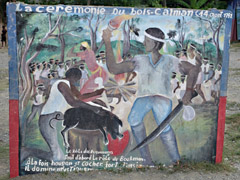
Painting commemorating the location thought to be the site of La Ceremonie du Bois-Caiman, August 14, 1791, a catalyzing event of the Haitian Revolution; Photo © Malick W. Ghachem, 2016